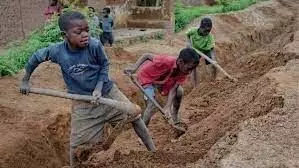- Home
- /
- Trending-News
- /
- Children in child...
Children in child labour stood at 39.2% in 2022- NBS

The National Bureau of Statistics (NBS) says that 24,673,485 children, accounting for 39.2 percent of all children aged five to 17 years old in Nigeria, are in child labour.
The NBS said this in its Nigeria Child Labour and Forced Labour Survey Report for 2022, which was released in Abuja on Thursday.
The Bureau said child labour refers to work for which children are either too young or that may be physically or psychologically injurious to their health and wellbeing.
The report said 31,756,302 children, accounting for 50.5 percent of all children aged five to 17 years old in Nigeria, were engaged in economic activities.
It said 14,390,353 children, accounting for 22.9 percent of children, were involved in hazardous work.
The NBS said the North-West zone had the highest number of children in child labour at 6,407,102 and in hazardous work at 3,266,728.
“However, in terms of the percentage of children in child labour and hazardous work, the South-East region has the highest prevalence of children involved in child labour at 49.9 percent.”
The report showed that in the five-to-14 age group, 77.6 percent of children attended school, 46.5 percent were working, and 11.2 percent were exclusively working.
“Children in urban areas are substantially less likely to be working and more likely to attend school than their rural counterparts. There are few differences between boys and girls.”
In the 15–17 age group, more than two-thirds of children were working, and 21.9 percent were exclusively working.
“Children living in rural areas are 12 percentage points more likely to be working and 17 percentage points less likely to attend school than children living in urban areas.”
The report said children from households with more educated household heads were less likely to be in child labour.
It showed that 43.2 percent of children from households where the head had reached primary or lower education were in child labour.
“Whereas only 28.4 percent of children from households where the head has a tertiary education are in child labour.”
The report said children from female-headed households were more likely to be in child labour than children living in male-headed households.
“About 42.5 percent of children from female-headed households are in child labour compared to 38.7 percent of children from male-headed households,” the NBS said.




